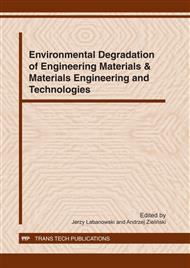p.49
p.57
p.65
p.71
p.81
p.89
p.95
p.101
p.107
Quality Investigation of Au Nanoarrays for Biosensing Application
Abstract:
The properties and ultrafast dephasing time of the Au nanoparticle structures produced for application in biosensors are investigated in dependence on their preparation conditions. The nanostructures are produced from thin Au films (10-20 nm) sputtered on SiO2 glass and annealed by pulsed (6 ns) laser radiation at 266 nm and at fluencies in the range of 10-412 mJ/cm2. The SEM inspection reveals nearly homogeneously distributed, spherical gold particles. Their initial size distribution in the range of 20-60 nm broadens towards larger particle diameters with prolonged irradiation. This is accompanied by an increase of the uncovered surface of the glass substrate and no particle removal is observed. In the absorbance spectra of the nanostructures the broad peak centered at 545-550 nm is ascribed to resonant absorption of surface plasmons. The peak position, halfwidth and intensity depend on the shape, size and size distribution of the nanostructured particles in agreement with literature. From peak intensities of the Raman spectra recorded in the range of 300 – 1800 cm-1 for the structures covered with Rhodamine 6G the relative signal enhancement by factor between 20 and 600 for individual peaks is estimated. Results confirm that the obtained structures can be applied for SERS measurements and sensing. The dephasing times estimated from homogeneous contribution of the absorbance linewidth range from 2.2 to 4.5 fs and correspond to particle diameters of 20-60 nm. It is shown that the dephasing rate 1/T2 can be tailored for particular sensor application by selection of the substrate preparation conditions.
Info:
Periodical:
Pages:
81-88
Citation:
Online since:
December 2011
Authors:
Price:
Сopyright:
© 2012 Trans Tech Publications Ltd. All Rights Reserved
Share:
Citation:


